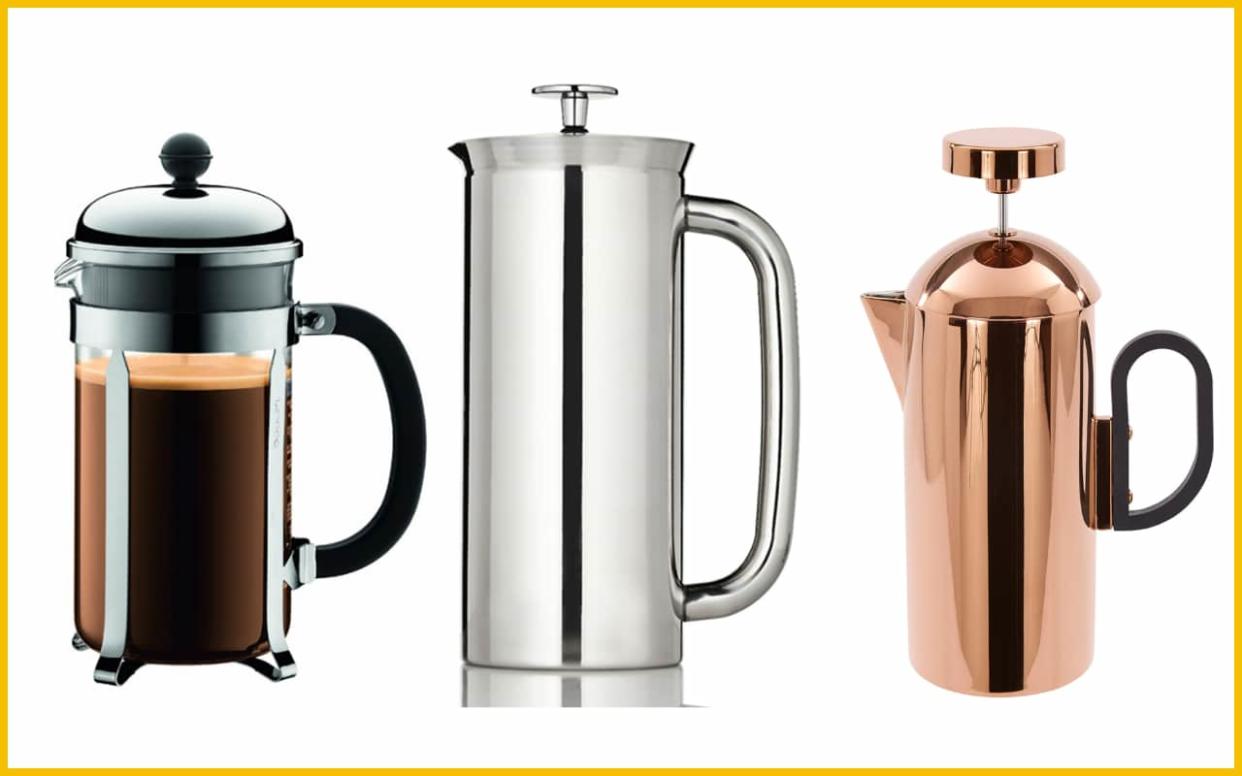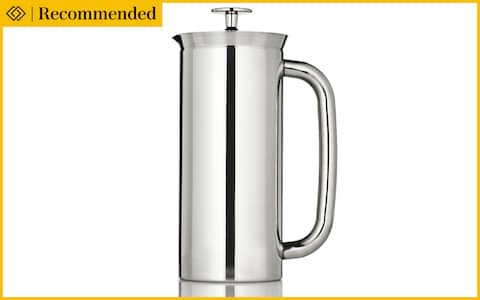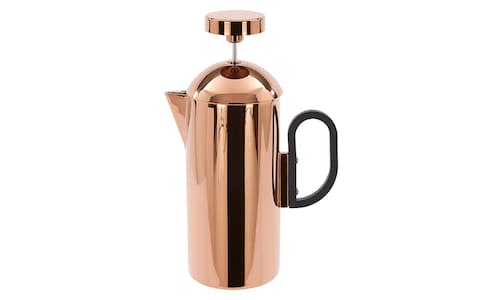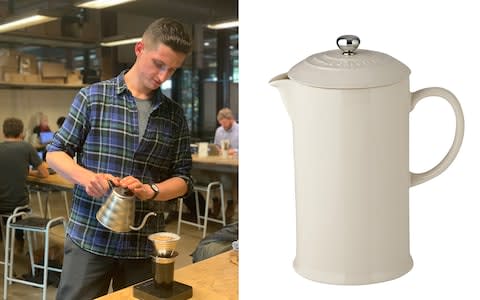The best cafetiere for perfect French press coffee

"We call this the London slurp," Alex Wallace explains, as he loudly ingurgitates a slug of freshly brewed coffee from a warm spoon. Apparently, this way it hits your retronasal olfactory receptors, where you perceive flavour the strongest – although I'm not sure you'll see it in Costa any time soon.
Wallace is head of quality control at Caravan Coffee Roasters, and today we're enjoying a cupping (coffee tasting) session at their Granary Square site in King's Cross. I'm here to learn how to brew a great cup of coffee at home, to dip my toe into the rabbit hole of coffee geekery, and to test and review the very best cafetieres that money can buy.
The cafetiere is one of the simplest and easiest ways for an entry-level coffee fan like myself to brew at home. Plus, it's sustainable. A cafetiere doesn’t require any paper filters or capsules, so you can never run out. (If that sounds like just your cup of joe, see the bottom of this article for Wallace's expert guide to brewing the perfect cafetiere coffee.)
We tried out a range of cafetieres, sampling both Caravan's Daily Blend (£7.50 for 250g whole bean) – a drinkable coffee, low in acidity, that works either black or with milk and sugar – as well as a slightly roguish, naturally processed "wild" coffee, Gutiti Natural, from Ethiopia – considered by many to be the homeland of Arabica coffee (£8.75 for 250g).
It's dried in the sun in order to retain fruit sugars for a more heavily fermented, funky, earthy, complex brew.
Here's my pick of the best, starting with the favourite...
Espro Press P7
Why we like it: Produces the silkiest cup of coffee of all

I had high hopes for the Espro Press P7 because it offers a simple improvement on the standard cafetiere: the plunger has a double filter, which promises less grit and sludge in your mug.
Happily, my hopes were not unfounded.
"The quality and efficacy of the Espro Press P7's micro-fine mesh filter is dramatically different to bog-standard filters, but still easy to use," comments Wallace. "The stainless steel is double-walled, so it does a good job of insulating. There's a fair amount of resistance when it comes to plunging, which is a sign that its doing the job of separating the grounds from the water."

The resultant coffee didn't disappoint either. "Coffee brewed in a French press will always retain a certain oiliness, because there's no paper to absorb it – but this has a thinner body, and is syrupy, super-clean and silky without being too gritty.
"It also has more clarity of flavour; the balance of acidity, sweetness and bitterness is distinct. It really stands out."
Our only caveat? The fine mesh proves a little tricky to wash up perfectly, though the parts are dishwasher safe (top rack only).
The large 32oz version featured here makes 6-8 cups, but it's also available in 18oz (makes 3-4 cups - £81.99, Amazon)
Stellar stainless steel French press
Why we like it: Insulating and durable, thanks to the quality of the steel
£45.99 for a 1.4 litre cafetiere, Wayfair

Another steel option, I'm afraid – but they really do the trick. This one is double walled and air insulated, and did a particularly good job of retaining heat. It's dishwasher safe, so it's a dream to wash up, and it doesn't drip at all, thanks to an argon-welded spout. Stellar are known for the quality of their steel cookware, so you're getting a premium product here.
The resulting cup of coffee, while delicious, is ever-so-slightly siltier and less delicately balanced than that produced by the Espro. Then again, this cafetiere is half the price.
It's built to last, but in case your filter gets damaged or lost, it's reassuring to know that the stainless steel filter inside can be replaced. It's available in three different sizes, depending on how many of you there are or how much coffee you like to drink: .3 litre (£27.99, Wayfair), 9 litre (£35.99, Wayfair) and 1.4 litre.
Bodum Chambord coffee maker
Why we like it: The best glass cafetiere we tried

The Bodum Chambord cafetiere comes with its own scoop. Because it's made of glass, it becomes hot to touch – an indicator that it's not the best insulator, so it won't keep your coffee as warm for as long as the steel products. However, that may be a moot point: if you don't tend to leave coffee sitting around in the pot for half an hour at a time, it won't matter to you.
On the plus side, because it's see-through, you can see the coffee. This gives you an element of control that you don't get from opaque steel, because you watch the coffee brew. For me, that adds to the brewing experience – although coffee geeks would respond that coffee should always be left to brew for roughly the same amount of time (Wallace suggests four minutes, give or take), so what does it matter?
Despite lacking the heat retention prowess of the stainless steel cafetieres listed above, the Daily Blend coffee we slurped was low acidity, and both bitter and sweet, with clear notes of cocoa and cinnamon. "It's not too course or gritty, and has that pleasing mouthcoating texture you're looking for," says Wallace.
This one has a capacity of 34 oz (6-8 cups), and is available in different sizes.
The long list
Le Creuset stoneware cafetiere

Despite being the most colourful, peacockingly Instagram-worthy cafetiere of the lot (it comes in a range of colours, including ombré volcanic orange, almond cream, flint, cerise, bright yellow, teal and blue), the Le Creuset ceramic stoneware cafetiere retains so little heat that during brewing it's so hot to touch that it might burn you.
I also fear that it's more breakable and fragile than the rest. It feels like it's more for display than practical use.
The resulting coffee (makes 4-5 cups) wasn't bad, but it did have a granular quality and a bit more harshness to it, suggesting the filter isn't as good as some of the others.
Tom Dixon coffee maker

Double-walled stainless steel, but with a a high-gloss copper finish on the outside, this art deco cafetiere makes six cups and certainly adds to the ceremony of brewing.
But Wallace isn't convinced: "This cafetiere is beautifully designed, but there's no other defining feature to make it worth the money, or any advantage over any other stainless steel cafetiere," notes Wallace. "In fact, it's missing the extra guard on the filter lip which many other cafetieres have to keep runaway granules out, just in case you plunge too fast."
Stelton EM French press

This plastic French press has a capacity of one litre and makes 8 small cups. It has a fiddly lock lid, which isn't ideal to navigate first thing in the morning (before your first cup of coffee). The scoop provided is quite small, and despite the fact that plastic is a good insulator, the resulting coffee has a granular texture.
When I use it for the first time out of the box, it also has a notably plasticky taste and aroma, which is detrimental to the flavour of the coffee (this gets better over time, but it certainly put me off to begin with).
A guide to brewing cafetiere coffee like a pro
"All you need to brew coffee in a cafetiere is a set of scales or a scoop to measure the grounds, boiled water, and freshly ground coffee, ideally from a traceable source," says Wallace. "The golden ratio for brewing coffee in a cafetiere is 60g of coffee per litre of water. If you don’t use enough coffee, you end up over-brewing the grounds, leading to a weak, bitter, ashy brew.
"But if you use too much coffee, and not enough water, you tend to underbrew the coffee, which brings out acidity and sourness. It can be thick and sludgy, and not so pleasant in the mouth.
"Temperature-wise, I like the water to be about a minute off-boil. Coffee brewed in a cafetiere should have a thick body to it. It should be sweet, and not overly bitter or sour, with a silky mouthfeel and as little grittiness as possible. I brew French press coffee for four minutes, and drink it as soon as possible after brewing.
"Coffee tastes best when its just above body temperature. We perceive sweetness and acidity differently at different temperatures; for example, if you eat ice cream, it tastes great out of the freezer – but when it melts, it becomes far too sweet and sickly."
The cafetiere is an "immersive" method of brewing coffee, in which the coffee grounds (the solute) are fully immersed in water (the solvent), housed in one big thermal insulator (the cafetiere) and then separated (with a plunge filter).
You can stir it, to increase the concentration. Before plunging the filter, Wallace recommends "breaking the crust and skimming the foam", by scooping the grinds from the top. The best cafetieres will leave the least amount of silty grounds in the coffee, leaving you with the desired silky texture.
Such is Wallace's dedication to the pursuit of a good cup of coffee that for the purposes of our experiment, he even whips out his refractometer, which measures the strength of the resulting coffee with a laser in order to determine the TDS (total dissolved solids) –the percentage of solids which have been dissolved and extracted from the coffee grounds (30pc is the maximum – a decent TDS might be around 20pc).

You should plunge it slowly because if you're too vigorous, the gritty particles of the grounds can escape. It also gives them a knock of energy, so they might release undesirable flavours, or upset the fine balancing act between sweetness, acidity and bitterness found in coffee. "I like everything to be gentle," Wallace adds. "Brewing coffee thoughtfully is a relaxing experience – part of it is about taking your time, and anticipating enjoying that first sip."
As I eye up a stoneware Le Creuset number, a shiny steel contraption from Stellar and a rather jazzy Tom Dixon design, I wonder what else I should be looking out for in a superior French press?
"Heat insulation is key," advises Wallace. "The hotter the liquid is kept during brewing, the better – especially if you want to leave it out and enjoy a second cup. If it's really hot to touch, that could mean too much heat is escaping. If it's cool to touch, or just warm, it’s retaining the heat.
You should always warm up your French press before you begin by filling and emptying it with hot water, so that energy isn't wasted heating it up. Ceramic tends to give off a lot of heat (which is bad news for my Le Creuset fetish); glass, metals such as steel and plastic are better insulators.
The coffee grounds for cafetieres should be courser than espresso, but not too chunky. "Around the size of a grain of cous cous works well," says Wallace (check out our guide to grinding fresh coffee at home for more wisdom on this).
His other top tips? "Don’t use London tap water," he urges. "It’s hard and alkaline with a high mineral content, so it’s bad for your kettle, and it brews a really chalky, strong, flat and thick coffee, removing all the distinctive flavours. At least use filtered water, and if you’ve got some really special coffee to try, use bottled water."
Coffee experts Caravan Coffee Roasters will open the doors to a new stand-alone roastery in Islington in late 2018. It is expected to roast nearly 200,000 worth of coffee every day, and will be combined with a coffee education studio, a brew bar and a café.


 Yahoo News
Yahoo News 
